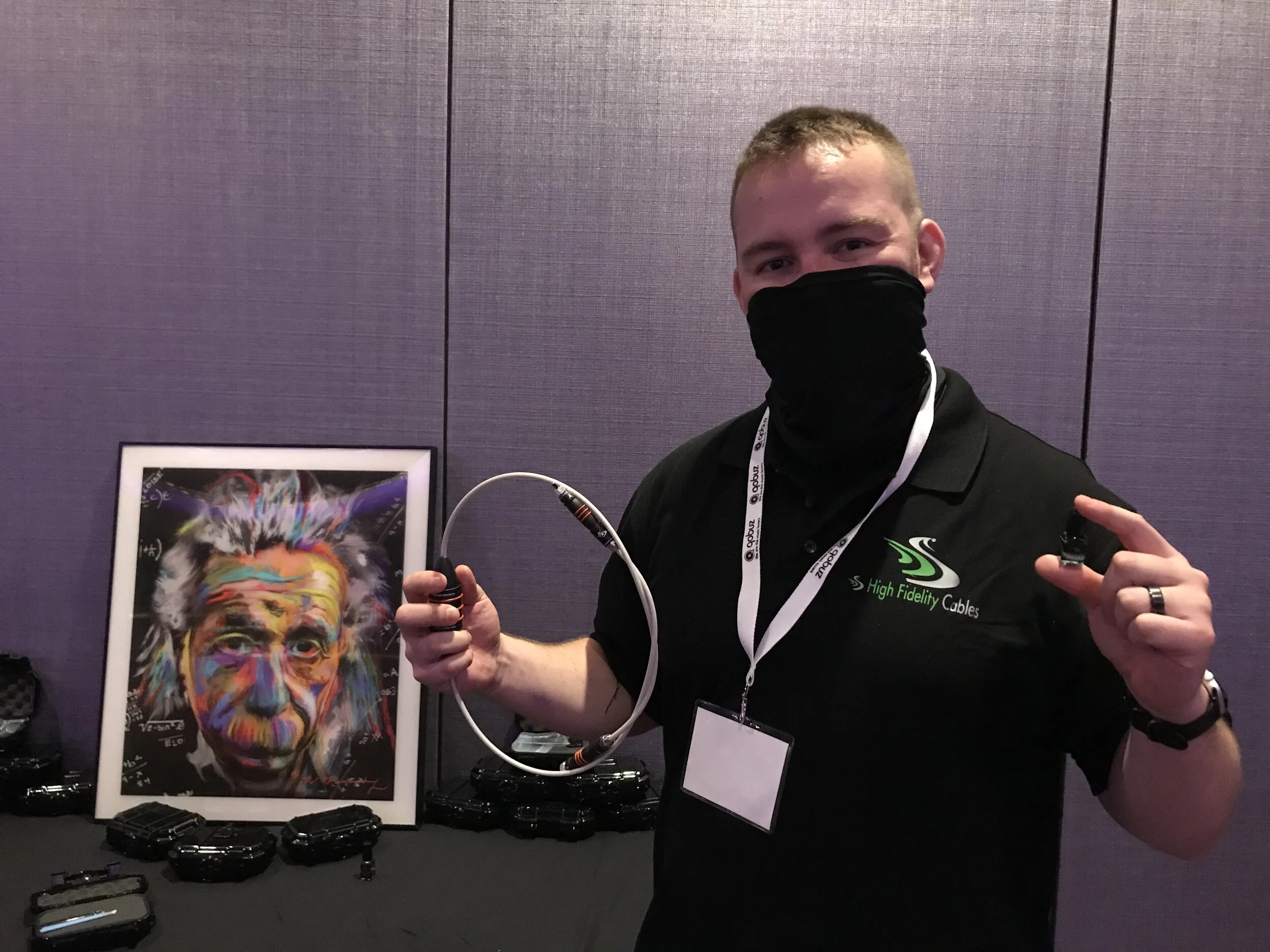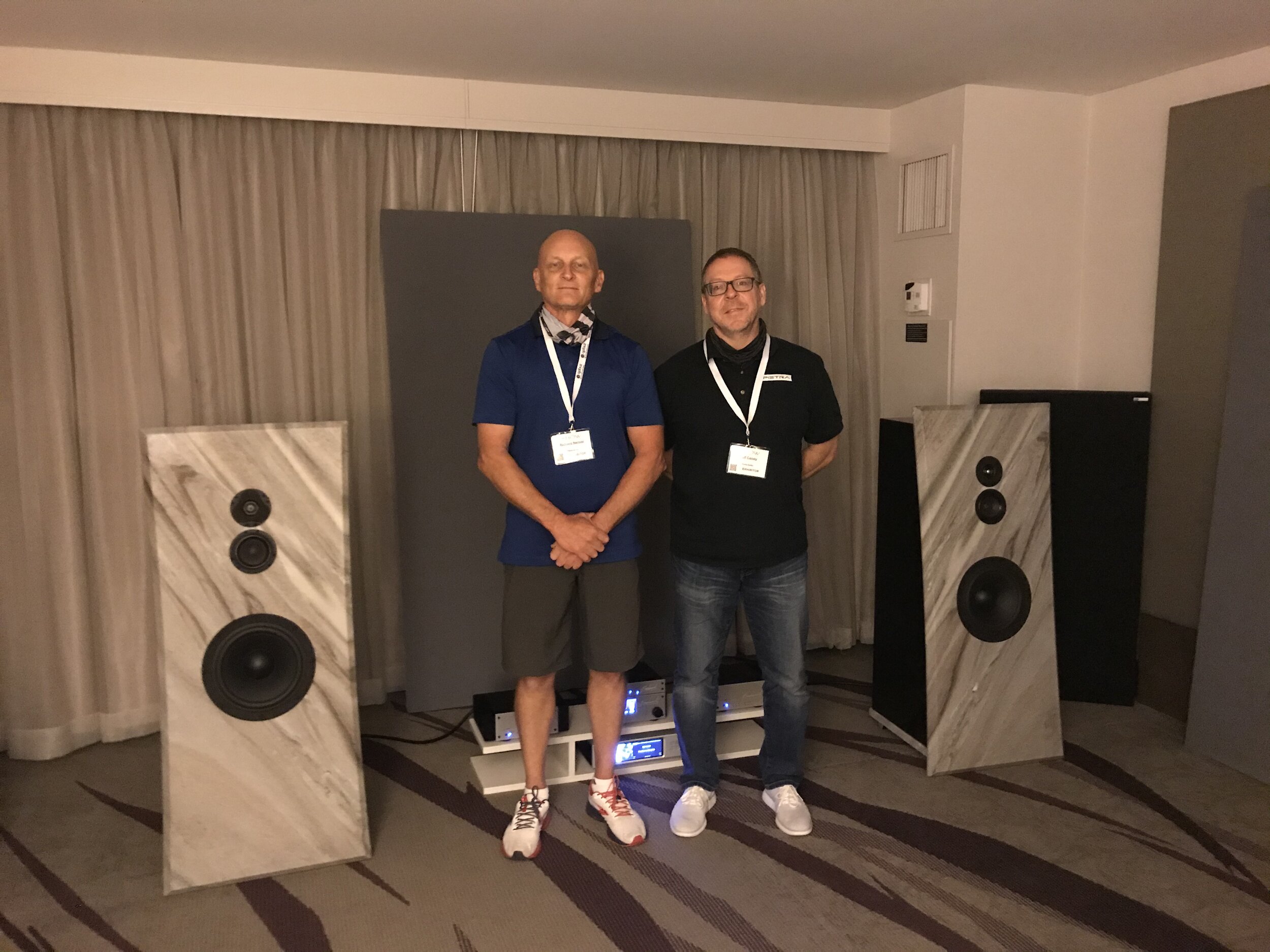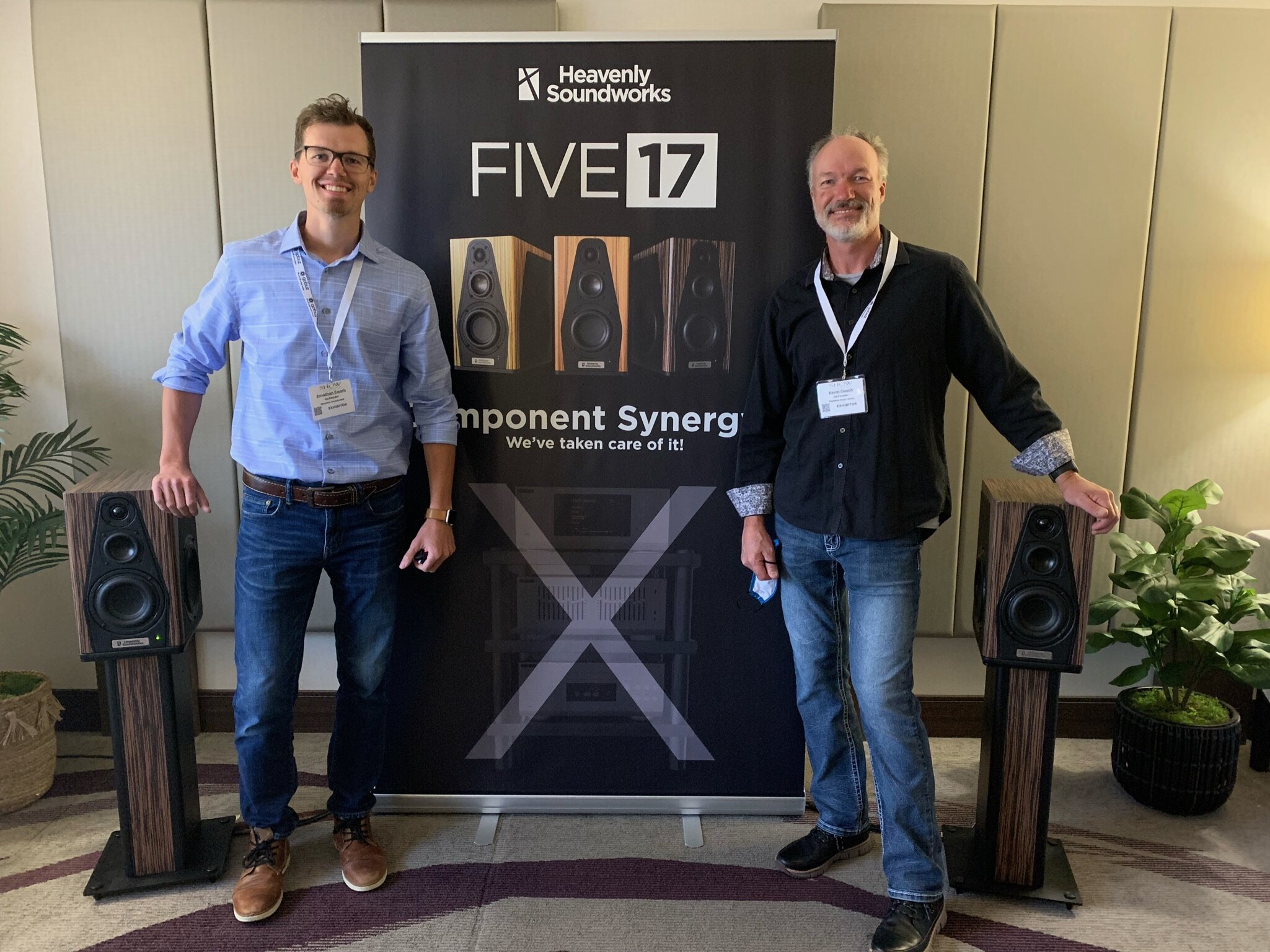First impressions
All prices listed in USD
My wife is not an audiophile. But as a classically trained pianist and a professional musician, she has ears for sound quality. It’s why I sometimes seek her opinion after changing something in my audio system.
This year’s T.H.E. Show, held in Long Beach, was her first audio show. It wasn’t that she was interested in going, but my son had my car and I needed a ride, and my wife doesn’t let me drive her car. So we drove together to Hilton Long Beach, the show’s venue, and soon after we’d arrived, there she was, surrounded by speakers as tall as her and cables that looked like missiles. And she loved it!
She enjoyed seeing all these people, mostly boomer-aged or older, running around in varying emotional states of curiosity, excitement, and exhaustion. She used a Korean word to call them “cute”, which, in Korean, is usually reserved for little kids. She also got a kick out of seeing a power cord listed for $100,000, called the Professional Elite power cable from High Fidelity Cables. “Let’s buy it!”, she said. I imagined her feeling like Alice in Wonderland.

I also saw the same thing that my wife saw, the stories in the eyes and behaviors of the attendees and exhibitors. I sensed the emotions under the masks — curiosity, excitement, restlessness, frustration, relief, sometimes a few of them at once. There was something intense coming from each person. And I thought, “This is pretty much what I saw and felt from the kids in my parents’ toy store. These people represented something alive, just as the audio equipment at the show represented something alive: music!”

Since the COVID-19 outbreak, I hadn’t been to any crowded event and this show was the first one in a long time. It felt good to mingle again. A few things, mostly people-related, stood out for me that opening day, like the passion of soft-spoken engineer Paul Paddock when he talked about his new speakers, the Forty-10 Loudspeakers from MC Audiotech ($35,000 / pair).

There was also the joyful excitement of the salesperson when I showed interest in a seemingly strange tweak solution he was offering,called NPS-1260 ($345 per bottle), a contact enhancer sold by High Fidelity Cables.

And there was the pride of sound-system designer Wayne Carterwho insisted that his system sounded like real music, and it did. That Friday, of the rooms my wife and I visited, his was the most unique and interesting because it was the only one that sounded like a live rock concert. I’m not sure how the average audiophile would have liked it but I’m absolutely positive there are some people who would love that direction. A couple of guys in the room were really rocking to ‘Riders on the Storm’ by The Doors.

On Friday, my wife and I were only able to check out eight of the 20 rooms at the show, but it was obvious to us that we liked the sounds of certain rooms more than others. And interestingly, we both preferred the same rooms. There could be many factors for our choices other than the excellence of the components: component synergy, the room’s acoustics, speaker placement, how broken-in the gear was, where we sat, how many people were in the room, or maybe it was the music they were playing.
About that last one: my wife and I had not brought our own recordings with us that first day of the show, and since every room was playing different music, we got curious about how the rooms we formed certain opinions of, and the ones we didn’t check out yet, would sound when playing recordings we know like the back of our hand. It made us look forward even more to returning to the show on Sunday, equipped with a few tracks we are extremely familiar with and a strategy to keep the volume consistent across rooms.
We were also eager to find out which room would come out as our winner, and learn what ingredients made it so special.
This is the third installment I’ve written about the show. As I promised in the preceding one, I’m going to report on the rooms I visited and reveal the one I thought deserved top honors. But just picking one winner is no fun, so I’ve decided to also pick the two runner-ups to round out a top three. The proviso is that only one room can be the best.
To accomplish my objective, my guiding rule was simple. From room to room, the same tracks had to be played at the same volume to level the playing field between them. I used a WAV file put together with an audio editor. It starts with three long beeps during which I would work with whoever is managing the room to find, via an SPL meter app and my ears, the correct volume. After that, we would play the first 30 to 50 seconds of each of these three recordings:
1. Dave Brubeck – ‘Take 5’ – from Time Out (Sony Music)
2. Chopin – ‘Etude in C major’ played by Murray Perahia – the first track from his Complete Chopin Etudes CD (Sony Music)
3. Eagles – ‘Hotel California’ – from Hell Freezes Over (Geffen) (That’s right. It’s my fault you hear this song at every show!)
Using the audio editor, I decreased the volume on Hotel California because a pop track is usually recorded much louder than a jazz or classical one, and I didn’t want the speakers to suddenly blast out a much louder sound.
So that’s how the fun began. Mind you, this method was not meant to be an evaluation of any one component, or even the whole system. The sound quality of a system really comes down to the whole room. And it reflects certain things whose effect is hard to define: how the speakers are set up, the room acoustics, where I sit, and many what-if scenarios.


To begin, I want to talk about the Margules room because that’s where my wife and I smiled the most. Margules is an audio company based in Mexico, a country we don’t normally associate with high-end audio. But the sound we heard in that room was anything but low-end.
Margules is a family business and their history goes way back to 1927 when the great grandfather of Jacobo Margules, the guy I mainly spoke with, helped build the first radio stations in Mexico and also built gramophones. I also had the pleasure to speak with Julian Margules, the company’s CEO and chief designer, Laura, the CFO and Julian’s wife, and Deborah, the industrial Designer and Jacobo’s sister. Even though they were wearing masks, the family’s warm hospitality came through.
And warm is exactly the word I’d use to describe the room’s sound. My wife and I both remarked, almost at the same time, that it reminded us of the Acoustic Energy speakers she bought for me as a wedding gift. (We still have them.) We’re attached to these speakers, both for their look and their sonic character, and saying the Margules room reminded us of them is a heartfelt compliment.
In the end, my wife picked the Margules room as one of her top three. I didn’t, but I had a hunch that it would have made it to my list had the company used a proper digital source, not a mobile phone and a wireless receiver.

Both the Pietra and the Wavetouch rooms had interesting-looking speakers. With their marble faces and a granite bodies, Pietra’s Model 3SG loudspeakers ($19,000 per pair) looked like they’d risen from the floor of a luxury mansion. Powered by Benchmark AHB2 mono blocks ($2999 each), the sound was balanced and engaging. I felt that I could play any music on this system to good effect.

Wavetouch’s Antero V2 speakers ($8000 per pair) probably had the most interesting look of all the speakers I came across. It had a long stick coming out of the bass driver, like Pinocchio’s nose, designed to direct sound waves. Alex Yoon, Waveform’s designer and owner, was in the room, and his enthusiasm as he explained his design to me was palpable. I was impressed by the clarity of the speakers’ sound despite the fact they were driven by very modest looking components.


Among the 20 or so rooms at the show, the one I was most curious about was the Wyred4Sound room, because I currently own one of their products and very much like it, the original DAC2 ($1499). Fronted by the Reference Standard 1 ($14,999 per pair), the first loudspeaker model from W4S, the music sounded smooth and musical. When I mentioned this to EJ Sarmento, W4S’s founder and chief designer, he said that that was exactly the sound he wanted. Don’t we all?
My Top 3 rooms! Plus a Top Honorable Mention!
3rd place – The High Fidelity Cables Room

If you walked in here, the first thing you would notice would be the huge size of the room, which meant more chairs and more people. So it was inevitable that the speakers needed to be very far apart from each other, which concerned me; I had never heard a satisfying sound from such a large setup. But the High Fidelity Cables system, fronted by the company’s Bafflex speakers (starting at $80,000 per pair) fed by their 70Wpc MA-70 mono blocks ($120,000 each), defied my expectations. I was more than 30 feet away from the system and the sound still hit me with a wonderful combination of ease, clarity, and coherence. It also produced a soundstage so big I felt I could rappel from it. While listening to the system, I couldn’t help wonder how it would sound in a more intimate setting, with the speakers closer together and me closer to them — would it sound even better? It didn’t matter. The sound was great as it was.
2nd place – The Tonian Labs Room

This room was much wider than it was deep which meant that people were forced to sit very close to the speakers. So, goodbye equilateral triangle, hello nearfield listening.
And guess what? The room sounded amazing. The presence of each voice, human or instrumental, was remarkable — tactile, palpable, mesmerizing. Moreover, imaging was outstanding. For example, I could tell exactly where Don Henley was sitting when he started to sing “Hotel California”.
Want even more good news? The Price! The Tonia Labs’ Oriaco G6 bookshelf speakers cost $3500 per pair (including stands!) and were driven by the $500 Marantz CD-67SE CD player and $1700 Denon PMA-1600NE integrated amplifier. But no need to use a qualifier like “Good for the price” here. I’m picking my top three in absolute terms, regardless of price, and the Tonian Labs room made the cut purely based on sound quality. It also made it into my wife’s top 3.
And now, ladies and gentlemen, here’s… (drumroll)
1st place – The Heavenly Soundworks Room

This is it, folks! The big winner! What can I say? When my wife and I heard the first few bars of Brubeck’s Take Five, we just looked at each other. Not a word needed to be spoken between us to convey what was going through our minds. Even without a subwoofer, the bass in this room was the deepest I’d ever heard in any room, ever, which doesn’t mean the system’s balance was leaning to dark. Quite the opposite. It was… illuminated. The Heavenly Soundworks system also struck me as providing the most faithful and realistic reproductions of the music on my three very familiar test tracks of any system I’d heard at the show.
Even as I’m writing this, I’m still trying to come to terms with how huge yet detailed the sound was. This dichotomy between bigness and refinement was the musical equivalent of watching a sumo wrestler knitting the daintiest lace-embroidered tablecloth.
Here’s something else that’s interesting: The Heavenly Soundworks system is almost just speakers — there was no outboard DAC, preamp, power amp, nothing but a $500 Bluesound Node 2i music streamer feeding the FIVE17 active, DAC-integrated speakers. A digital file containing music ripped from my CDs was used for playback.

These extraordinary speakers were created by a father-and-son team, Kevin and Jonathan Couch. As I was speaking to them, the word synergy came to my mind. They seemed so attuned to each other and single-minded in their vision that I imagined there’d be no need between them for endless meetings, constant back-and-forth emails, or trying to get their point across to each other in a screaming match. It reminded me of the synergistic-like sound I heard in their room.
After 17 pairs of speakers and 20 amplifiers, I am still looking for that sort of magic chemistry in my system. But in that room devoid of electronics and cables, I couldn’t help but think that people like the Couches, and the designers of some other active speakers and integrated systems, know better than I do when it comes to component-matching.
Oh, and the Heavenly Soundworks room was also my wife’s first pick of the show.
Honorable mention — The Reference Components Room

This room, with its beautiful Zingali Twenty 1.2 EVO 30th Anniversary Edition speakers ($21,000 per pair) driven by all tube amplification courtesy Cary Audio’s CAD-805 Monoblocks ($15,995 per pair) and SLP-98P preamplifier ($4,995) sounded so good — it was the most satisfying musical experience of the show — it should’ve received more than an honorable mention. Alas, their only source was vinyl and they couldn’t play my test tracks, and the point of using my test tracks was to level the playing field among rooms.
Still, I was intrigued by all the little acoustical tricks sprinkled across the room. I saw blue tape markings on the carpet for that one optimal listening position, card boards covered in cloth carefully placed on the side walls, and silk fabric wrapped around the curtain rod which, according to company rep Jim Dasteel, was meant to keep the metal rod from ringing. He told me that all the setting up and tweaking took more than a whole day, and was done by L.A.-based audio consultants Jay Nakamura and Victor Liang .

The Reference Components room was hosted by Italian company Zingali, makers of the speakers, while all other components were loaners. It was obvious just by the attention to detail paid in treating the room that Zingali must have chosen its associated audio equipment with utmost care, hence my eagerness to hear the system. Luckily, they had an album I was very familiar with, Friday Night in San Francisco by Al Di Meola, Paco De Lucia, and John McLaughlin.

And there my wife and I were, listening through the entire first track, “Mediterranean Sundance”. And it was the most electrifying listening session we had at the show. I wasn’t sure where exactly the magic was coming from. Was it the speakers? The tubes? The room acoustics? Perhaps because it was vinyl? I stopped wondering, afraid I would ruin the magic if I started analyzing it too much.
In that moment, I felt profoundly grateful to be having such a transcendent experience with my life partner who used to not care about this type of stuff. I felt grateful to everyone who helped make it happen, including the musicians, the producer, the makers of these wonderful tools that play back a recording in such a high sound quality, and T.H.E. Show’s team, especially Director of Social Media and Marketing, Emiko Carlin. And that list would expand indefinitely if I included everyone who made it possible for my wife and I to be there together at that precise moment.
Thank you all, and hope to see everyone again next year!










Leave a Reply